Author: Marshall Schott
True story: I have a neighbor who flies F-15 fighter jets for a living, the walls of his in-house bar adorned with plaques and rad photos way cooler than the cover of Top Gun. A couple years ago, I built Jersey, as he’s known at work, a 3 tap keezer that he keeps stocked with commercial kegs of a popular Witbier and something easy drinking like Firestone-Walker DBA or 805. Out of the third tap always flows a tasty IPA such as Ballast Point Sculpin, Firestone-Walker Double Jack, or some other West Coast example of the style. Due to his odd work schedule, Jersey isn’t able to lend me his palate too often, but he happened to be around while I was collecting data for the flaked oats xBmt, the first NEIPA I’d ever made. After completing the survey, I offered him a full pint, which he gladly accepted. Now, this isn’t a dude who spends hours researching different beer styles or posting masturbatory tasting notes to review websites, he just loves good beer, which is largely why the comment he made following his first non-evaluative sip caught me off-guard.
“This is so juicy I could drink it for breakfast!”
I proceeded to explain to him what New England IPA is and how it differs from the IPA he’s used to drinking, namely in regards to appearance and that “juicy” character he noted. With results from that xBmt showing flaked oats didn’t produce a distinguishable difference, my focus shifted to another method used by brewers of NEIPA that’s believed to contribute to its unique character.
Simply put, biotransformation is said to occur as a result of the interaction of hop oils and active yeast, leading to a transformation of certain terpenoids into terpenoids that weren’t originally present. A fascinating concept that many have posited may be responsible for the qualitative differences between New England and other styles of IPA.
| PURPOSE |
To evaluate the differences between beers where the dry hops were added at either high kräusen (biotransformation) or at the end of fermentation (standard).
| METHODS |
Designing this xBmt required enough consideration to make it a royal pain in the ass. After consulting with a bunch of people, it was ultimately decided that brewing the standard dry hop batch two days before the biotransformation batch would be the most prudent approach, as it would allow both to be dry hopped and packaged at the same time, eliminating dry hop contact duration as a confounding variable. Because of this, I ended up brewing the same exact beer 2 days apart, which on its own ostensibly introduced other potential factors that could have impacted the results. I’ll do my best to address this stuff where necessary, though in order to keep this section from getting to palaverous, I’ve opted not to fully detail both brew days.
I based the current recipe on the first NEIPA I made for the flaked oats xBmt, making a couple minor changes based on ingredient availability and numerous recommendations I received to double dry hop.
NE(ver) Clear IPA
Recipe Details
| Batch Size | Boil Time | IBU | SRM | Est. OG | Est. FG | ABV |
|---|---|---|---|---|---|---|
| 5.5 gal | 30 min | 47.9 IBUs | 3.7 SRM | 1.056 | 1.013 | 5.7 % |
| Actuals | 1.056 | 1.011 | 5.9 % | |||
Fermentables
| Name | Amount | % |
|---|---|---|
| Pale Malt (2 Row), Rahr | 11 lbs | 88 |
| Oats, Flaked | 1.5 lbs | 12 |
Hops
| Name | Amount | Time | Use | Form | Alpha % |
|---|---|---|---|---|---|
| Columbus/Tomahawk/Zeus (CTZ) | 8 g | 30 min | First Wort | Pellet | 13.1 |
| Centennial | 30 g | 15 min | Boil | Pellet | 8.8 |
| Centennial | 30 g | 5 min | Boil | Pellet | 9.9 |
| Citra | 30 g | 5 min | Boil | Pellet | 14 |
| Mosaic | 30 g | 5 min | Boil | Pellet | 10.5 |
| Citra | 60 g | 6 days | Dry Hop | Pellet | 14 |
| Centennial | 30 g | 6 days | Dry Hop | Pellet | 8.8 |
| Mosaic | 30 g | 6 days | Dry Hop | Pellet | 10.5 |
| Citra | 33 g | 4 days | Dry Hop | Pellet | 14 |
| Centennial | 22 g | 4 days | Dry Hop | Pellet | 8.8 |
| Mosaic | 20 g | 4 days | Dry Hop | Pellet | 10.5 |
Yeast
| Name | Lab | Attenuation | Temperature |
|---|---|---|---|
| London Ale III (1318) | Wyeast Labs | 73% | 64°F - 74°F |
Notes
| Water Profile: Ca 135 | Mg 1 | Na 10 | SO4 71 | Cl 186 | pH 5.4 |
Download
| Download this recipe's BeerXML file |
Again, weighing the pros and cons, I decided to make a single large starter, half of which would be pitched into the standard dry hop batch while the other half would be left in the flask two more days before being pitched. Based on speculation that biotransformation occurs as a function of yeast strain, I made a starter using 2 packs of the popular-for-the-style Wyeast 1318 London Ale III a couple days before brewing the standard dry hop batch.
For each batch, I prepared the brewing liquor and milled the grain the night prior to brewing.
I awoke early on a Saturday morning then again the following Monday morning, in each instance starting my brew day by lighting the burner under my kettle full of liquor.
Once heated to a bit above my target strike temperature, I transferred the water to my mash tun, let it sit for a 5 minute preheat, then incorporated the grist to hit the same desired mash temperature in each batch.
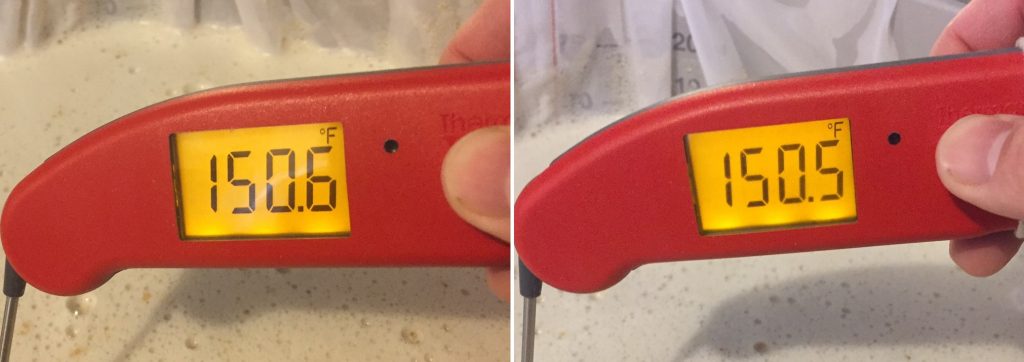
Both beers were brewed using the no sparge method and were left for precisely the same 60 minute saccharification rest.
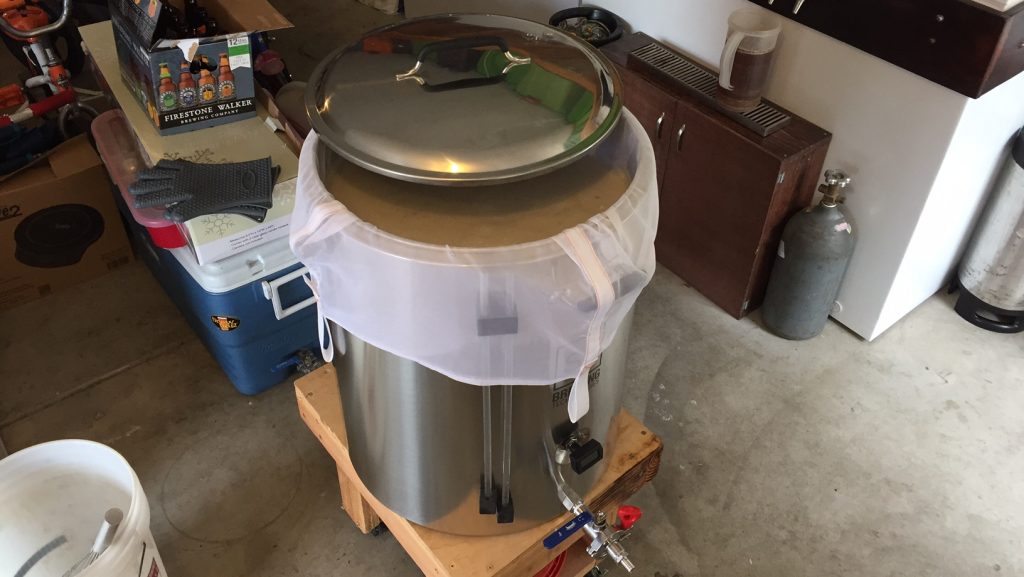
At the completion of the mash step, the same volume of sweet wort was collected in a bucket and transferred to a kettle.
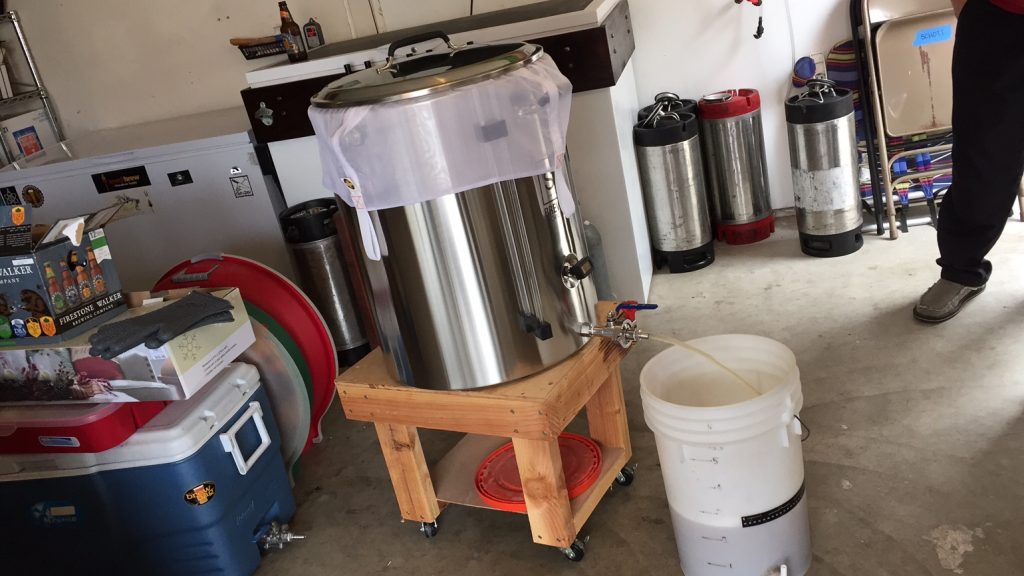
Both worts were boiled for 60 minutes with hops being added at the same times in each.
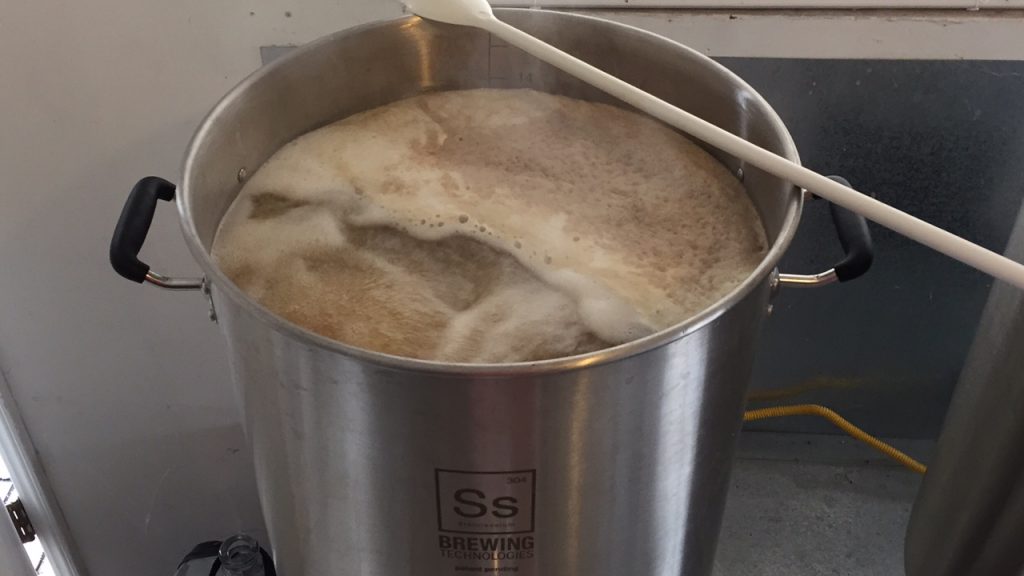
I quickly chilled each batch of wort as soon as the boil was over.

Refractometer readings revealed the standard dry hop wort clocked in with slightly lower OG than the wort that would receive the biotransformation dry hop addition.
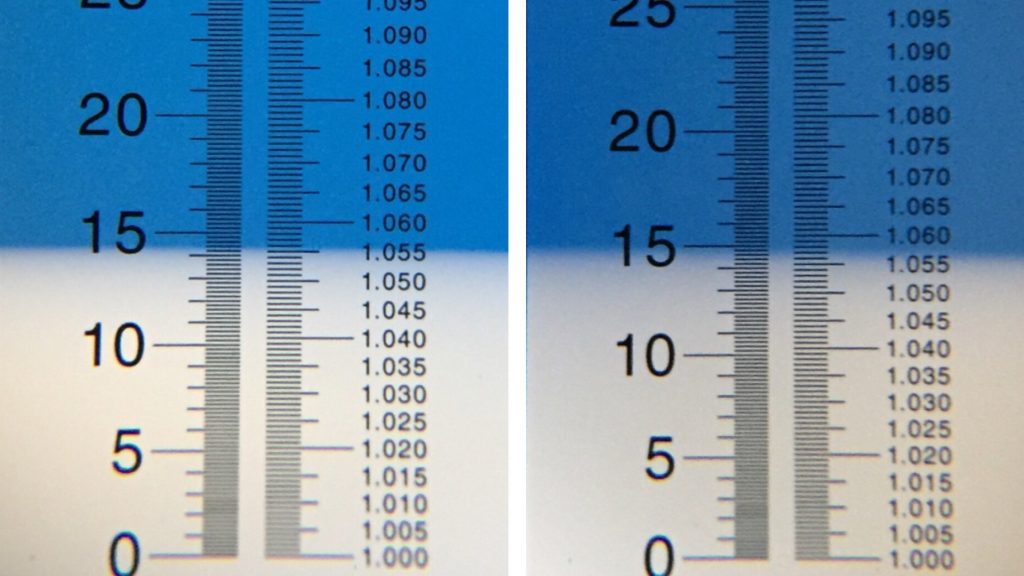
For the sake of consistency, I allowed both fermentors of wort to sit in a chamber controlled to my target fermentation temperature of 66°F/19°C for 3 hours before pitching the yeast. At the time I pitched the biotransformation wort, the kräusen on the standard dry hop beer was beginning to fade. The following day, I noticed the biontransformation batch was beginning to develop a kräusen, though it had yet to achieve the rocky appearance I was waiting for. Approximately 40 hours after pitching, the biotransformation beer had achieved high kräusen and the standard dry hop batch appeared close to being done fermenting.
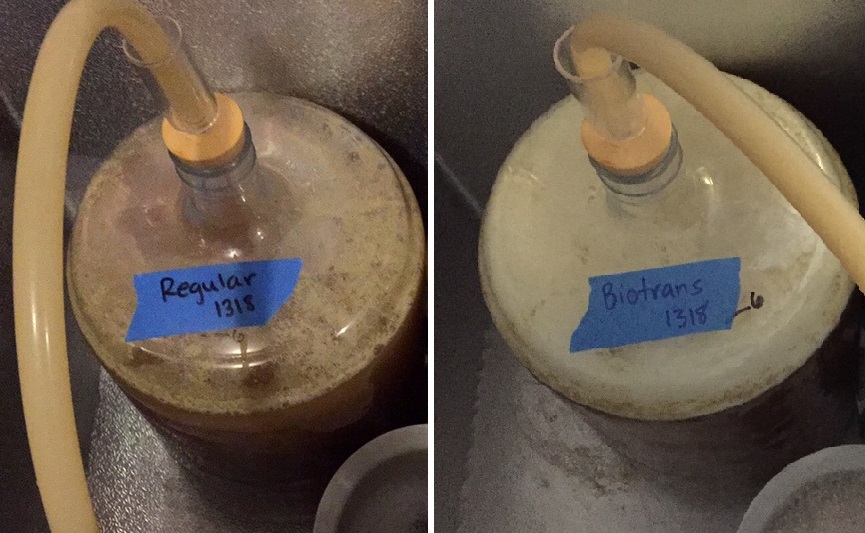
I proceeded to dry hop both batches with the same amount of hops, giving each a very gentle swirl to ensure they didn’t remain on top of the beer. After 2 more days, I raised the temperature of each chamber to 72°F/22°C to encourage complete attenuation of the beers. Finally, another 2 days later, when fermentation on both beers looked to be dying down, I took hydrometer measurements that revealed the biotransformation batch still had a little ways to go.
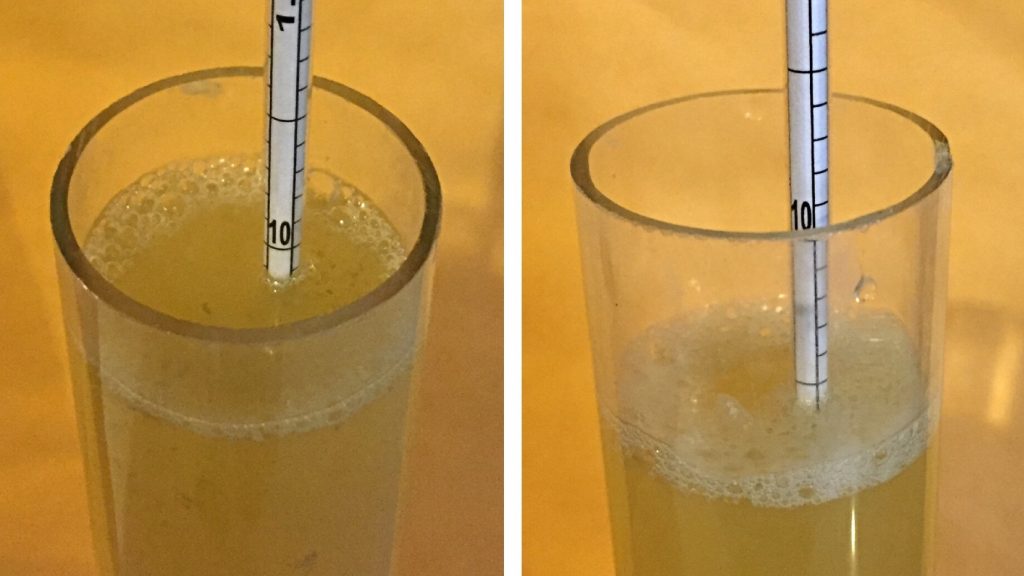
Another round of hydrometer measurements the following evening revealed the biotransformation beer had indeed dropped to 1.012 FG, just 0.001 SG higher than the standard dry hop beer. At this point, I added the second dry hop dose and left the beers alone for 2 days before an overnight cold crash then transferring to kegs.
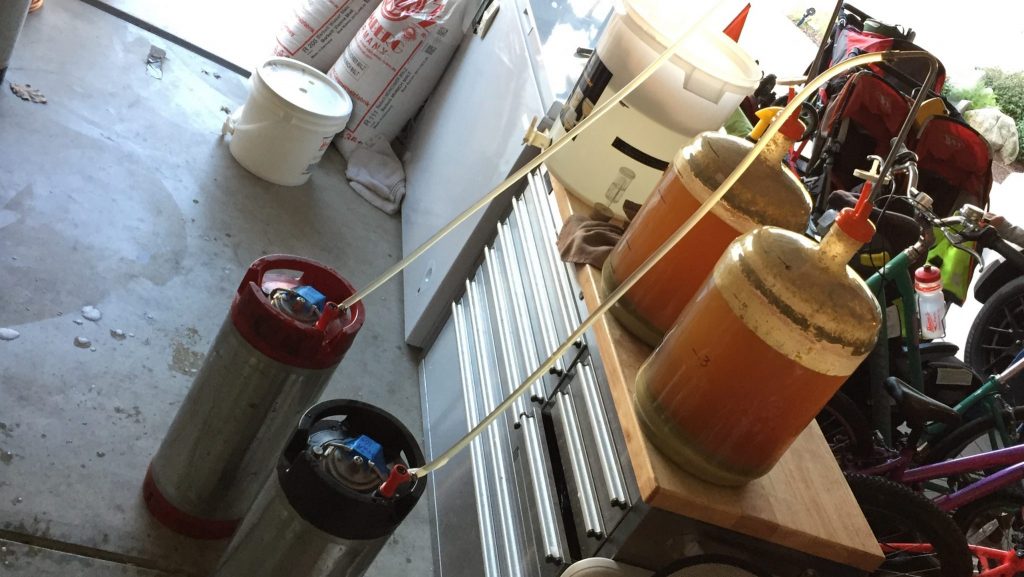
The filled kegs were placed in my keezer on higher pressure for a 24 hours burst carbonation, after which I reduced to serving pressure and let them condition cold for 4 days before serving them to participants. At this point, the beers were surprisingly easy to tell apart by appearance alone, the standard dry hop sample noticeably darker and a touch clearer than the biotransformation beer.
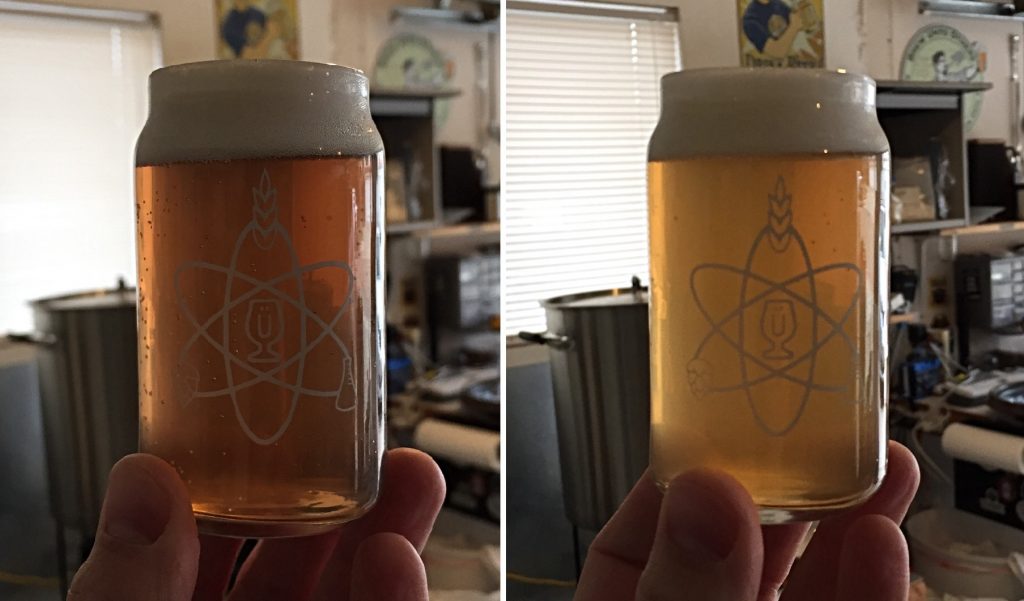
Two weeks after data collection was complete, I poured myself a couple more samples just to see how things were progressing. The difference in clarity left me feeling somewhat hopeful.
| RESULTS |
A total of 28 people of varying levels of experience participated in this xBmt. Each participant was served 1 sample of the biotransformation dry hop beer and 2 samples of the standard dry hop beer then asked to identify the sample that was unique. Given the sample size, 15 tasters (p<0.05) would have had to correctly identify the biotransformation beer as being different in order to reach statistical significance. A total of 11 tasters (p=0.31) accurately identified the unique sample, indicating participants in this xBmt were unable to reliably distinguish a NEIPA dry hopped during high kräusen from one dry hopped toward the end of fermentation.
To satiate curious minds, and because I think it’s sort of telling, I’ll share the preference data that’s arguably meaningless given the non-significant results. Of the 11 participants who were correct on the triangle test, 5 reported preferring the biotransformation beer, 4 liked the standard dry hop beer more, and 2 felt they weren’t different.
My Impressions: After my first experience brewing a NEIPA, I was pretty stoked to get these beers on tap, not only because I enjoyed drinking that first batch, but because I really thought this variable might help explain some of the unique aspects of this style. I poured my first few samples in clear glasses while the beers were still cold conditioning and based on appearances alone, I was pretty certain I’d be able to tell them apart, the standard dry hop beer noticeably darker and less “juicy” looking than the biontransformation beer. Fully owning that I preferred the look of the biotransformation beer, I was curious to see how I’d perform on a series of semi-blind triangle tests. Over the course of a few days, I made 8 attempts, out of which I was correct 5 times. It wasn’t easy, there were a few times I threw my hands up and guessed luckily, and ultimatley, 5/8 is 1 shy of significant. The only difference I felt I could pick up was a slightly more malty character in the standard dry hop beer, not that it wasn’t as hoppy as the biotransformation beer, just that it had a whisper more malt presence.
Unlike my first NEIPA, I wasn’t a huge fan of this beer. It actually reminded me of a few commercial examples of the style, way too soft on the palate with a much stronger pine character I can only attribute to the use of Mosaic instead of Galaxy.
| DISCUSSION |
I think every researcher, whether of the garage or lab variety, yearns for that eureka moment when results confirm a hypothesis. This was certainly the case for me with this xBmt– after demonstrating that neither the absence of fining nor flaked oats were responsible for the “juicy” character common to NEIPA, at least on their own, I’d all but convinced myself the culprit was biotransformation dry hopping. Suffice to say, the fact tasters were unable to reliably distinguish a beer dry hopped at high kräusen from one dry hopped at the end of fermentation really surprised me. However, the fact the biotransformation beer maintained a noticeable and familiar haze while the standard dry hop batch was clearer is pretty exciting, as it demonstrates dry hopping during high kräusen may in fact be one part of the NEIPA gestalt.
My hunch is the haze in the biotransformation beer is what made it appear lighter in color than the beer that was dry hopped at the end of fermentation. An interesting observation, regardless. The biotransformation beer definitely looks more like a typical NEIPA with its creamy orange hue, supporting previous findings that something occurs when dry hopping at high kräusen. Admittedly, this made me wonder the extent to which perceptions and subsequent descriptions of this style are influenced purely by the way the beer looks– like orange juice.
I’m not sure if it was my use of Pale malt instead of Maris Otter, Mosaic instead of Galaxy, a lower percentage of flaked oats, or all combined, but my experience with these beers on a sensory level was rather disappointing. Thankfully, Jersey really enjoyed them and while I remain committed to exploring the individual unique components involved in making NEIPA, I think I’ll take a break and make some higher sulfate, NOat, West Coast IPA to clear my hazy head.
If you have any thoughts about this xBmt, please do not hesitate to share in the comments section below!
Brülosophy Merch Available Now!
Follow Brülosophy on:
FACEBOOK | TWITTER | INSTAGRAM
If you enjoy this stuff and feel compelled to support Brulosophy.com, please check out the Support page for details on how you can very easily do so. Thanks!

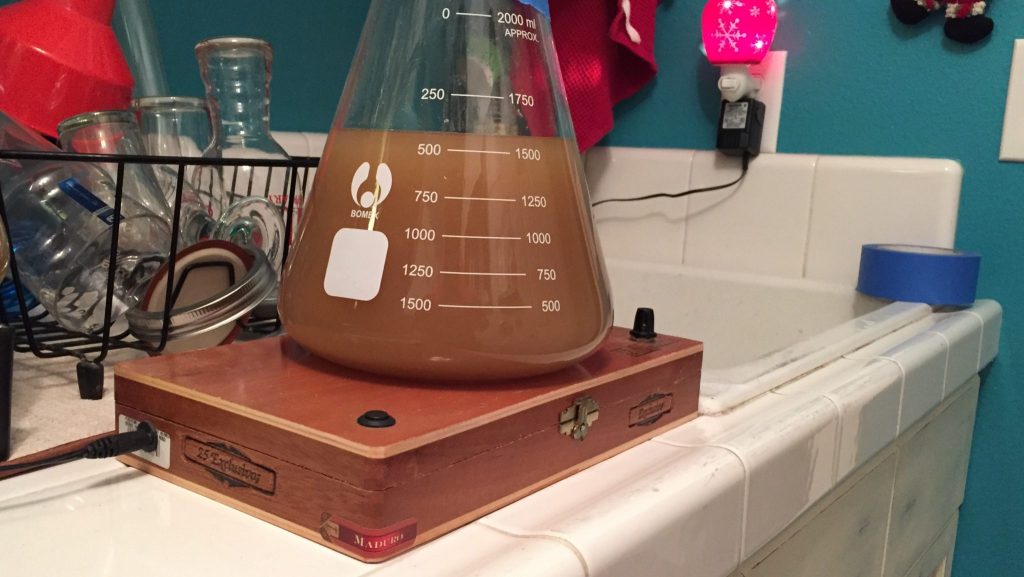
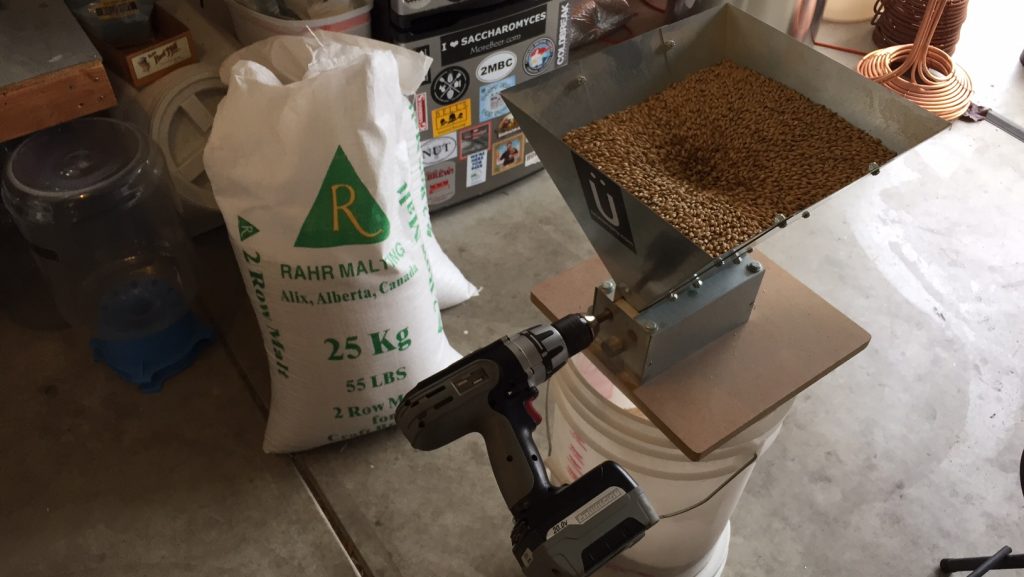
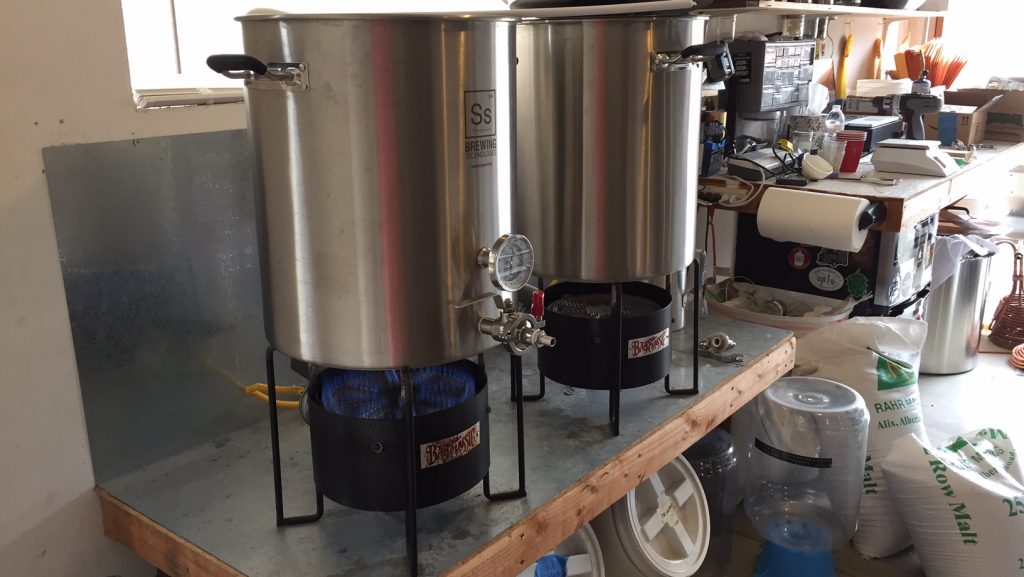
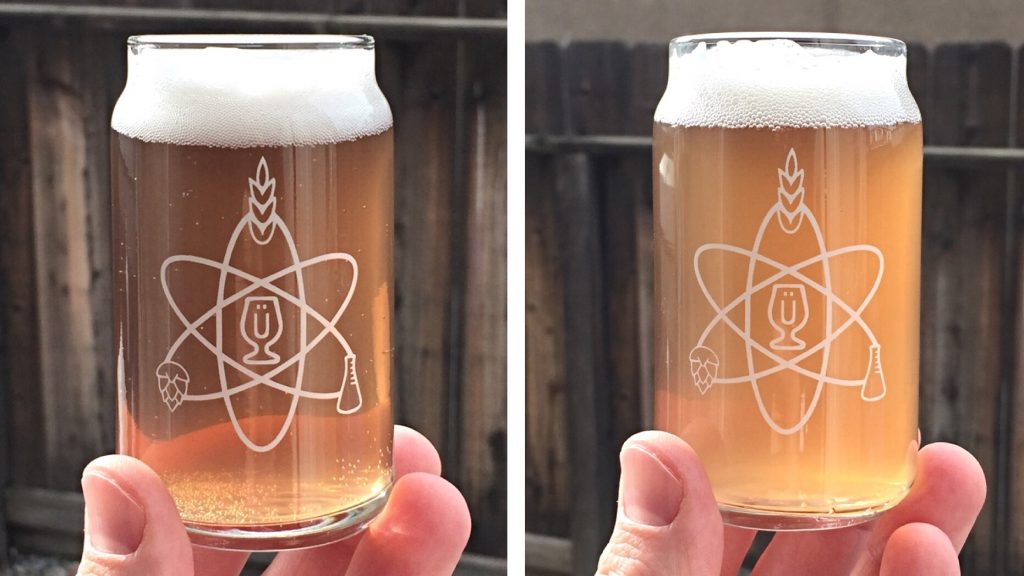










36 thoughts on “exBEERiment | Biotransformation vs. Standard Dry Hop In A Hazy IPA”
>Given the sample size, 15 tasters (p<0.05) would have had to correctly identify the Oats beer as being different
Oats beer? Aren't they both Oats beers?
My late night research on the topic lead me to believe the enzyme beta-gulcosaide was responsible for biotransformation. It appears beer yeast is really poor in that enzyme, but Brett and some wine yeasts do well. I’m brewing a split batch with one half being dry hopped with QA-23 wine yeast to see for myself if it makes a difference I can perceive.
Beta-glucosidase (will type “BG”) activity is just one aspect of this. BG enzyme will cleave glycosides, which are flavor molecules bound up in a sugar. This theoretically releases more flavor compounds, but doesn’t transform them into other compounds, which is what “biotransformation” is. Biotransformation is not well understood yet, but it has been established that it is happening… science just isn’t sure how it is happening yet.
Here is a summary of these two things that I wrote for MTF: http://www.milkthefunk.com/wiki/Hops#Hop_Derived_Compounds_In_Beer_and_Biotransformations
I love when Dan shows up!
That is amazing information. Thank you so much!
great xbmt. i think a lot of people also still dry hop in “secondary”, which could magnify the haze difference even more. also, NEIPA breweries are maybe just using more dry hops than most West Coast style breweries? I am pretty convinced that the haze in NEIPA is due to the very large, early dry hop and not much else. the juiciness is from a large amount of fruity hops in a beer with little malt character or bitterness. Thanks for doing two brews for this!
That doesn’t explkain how my beer (fined with gelatin) with 20% oats and lots of late hops, remained hazy despite a standard dryhopping schedule like the above. (no biotransformation hopping)
I still believe that the haze is a function of high % oats and the hop oils bindingwith oats/yeast together.
its not “1” thingthat causes it
My latest two NEIPAs were 2-row, crystal and carapils, a few bittering hops and then a very large dry hop. The resulting beer is a classic NEIPA according the the descriptions. Flaked grains are not necessary. The one thing I haven’t tried is using a nontraditional NEIPA yeast with this method to see if the beers are as hazy and hoppy. Others report using all kinds of yeast and still get hazy beers apparently. You can tweak lots of variables, as many have, low chloride, high chloride, low gypsum, high gypsum, flaked grains, no flaked grains and still get a classic NEIPA. The one thing they all have in common is heavy dry hopping. I HAVE brewed a few WC style IPAs that clarified amazingly quickly though. Several of my WC style ones stay as hazy as an NEIPA though too. Definitely more room for experimentation here.
Did the increased haze result from “biotransformation” into more turbid compounds, or was it a result of making yeast less flocculant and therefore having more yeast still in suspension?
Do you have a microscope with phase contrast?
Thanks again for another awesome xbmt! I wonder if the beers might have tasted more different without that second dry hop, therefore just comparing one biotransformation dry hop, vs. one regular.
I think the NEIPA style is driven by a number of factors including Dry Hopping methods, Water Chemistry, Yeast Selection and Adjunct Grain additions (wheat and oats). Testing these items individually will give you part of the story, but not the whole story… IMHO.
my thoughts too.
although testing the variables individually helps to give a clear picture that it definitely isn’t one thing that makes the haze effect.
xbmt 1 gelatin fining as normal NE beer.
xbmt 2 oats v no oats
xbmt 3 biotransformation vs standard.
xbmt 4 should probably be a yeast change (I’d suggest 090 or something similarly flocculant)
Very illuminating beerxperiment. Since it’s well known we all taste with our “eyes”, I find it remarkable that at least a sizable component of the NE IPA taste may be coming from purely cosmetic hazy appearance (that many people find off-putting), not from the flavor/aroma itself.
Interesting xbmt, and one I was wondering about too. Regarding triangle tests, I think they are harder than most people think. My wife and I are both reasonably experienced wine drinkers/tasters/snobs, and have fairly discerning (but totally different) palates. We did a triangle taste of our two identical neipas that differed only in chloride and sulfate levels, 180/60 in one, 40/160 or so in the other. While the 2 beers are notably different, I found it difficult to correctly identify them, possibly due to not clearing my palate enough between tastes. I could nail the first two as being different from each other, but couldn’t always figure out the 3rd one without really taking my time. I know there’s a difference. I can taste the difference. But out of 3 samples it is still difficult to tell which one there are two of, and which one there is only one of.
Hmm. I’m compelled to believe bias may be at play in your belief the beers are notably different, especially if you struggled to distinguish the unique beer in the triangle test. We offer tasters water to palate cleanse, though in my experience, most people don’t prefer doing that, but rather go through each sample as quickly as possible. In my own trials, I’ve stopped palate cleansing between samples as well, I find it easier to notice difference when the beers are compared very quickly. You certainly know there’s a difference because you made the beers differently, which is necessarily going to bias you (it does all of us) to think you can taste a difference; the triangle test is designed to account to some degree for this bias.
This would be cool to try at our local brew clubs/etc. Marshall, do you have a spreadsheet or something that you could share for doing a triangle test?
I agree with Geoff – the 2nd dry hop might have masked any differences from the first one. Dry hopping with pungent hops like Citra and Mosaic can blot out subtle flavours.
Trillium mosaic hopped beers are typically clear. They feel that what ever proportion of hop oils OR specific hop oils that are in mosaic hops are the reason for this clarity. If you did this with Galaxy, you would get a cloudier appearance. Also, they are dry hopping under pressure which may also be contributing to the appearance. Cheers!
Where did you hear this? Mosaic FP, Artaic, and Melcher Street were all hazy when I tried them. Melcher Street is described as hazy on Trillium’s site.
Thanks for doing this one. I appreciate the consideration that goes into trying tease out hop variables like this. For instance, although you controlled for dry hop contact time in each batch, the extra two days in the standard batch could have led to greater decline in hop presence that came from late boil and flame out additions (although nothing reliably noticeable, evidently). There may not always be a perfect solution for the research design, but it’s great to see tests of different hop variables like this one.
i’ve made a handful of NE style IPAs or Pale ales and also found that I did not like the beer at all when I used pale malt. It was just too cloyingly sweet and even a fat dose of amarillo couldn’t cure it. I’m sticking to 2 row from now on (or golden promise, or maris otter, or what have you)
Early on in my brewing I made a batch that stayed cloudy for months. I even used clariferm on it. It was a dead guy ale clone recipe with no flaked barley, oats or wheat. I undershot my O.G. and I believe the reason was because the conversion wasn’t complete during the mash. The taste was great, excellent mouthfeel and embarrassingly cloudy. Do you think this could be a factor in the haze and mouthfeel of NEIPAs?
I still think the real trick to beers like Heady Topper/Focal Banger, Tree House’s Julius, and others is the use of hop oils. I just bought an 8oz bottle of hop oils and if the Brulosophy team would like me to send them some for future experiments I’m happy to mail you an ounce of it (which is more than you’ll ever need). I just picked up fresh beers from The Alchemist last week and at least know what I’m shooting for…
Do you think the hops will improve yeast health by lowering the pH of the ferm? I have used hop extract in a continuous fermentation to lower lactic and acetic acid generation by the yeast.
Thoughts?
I really have no clue, though I can see how this could potentially be the case.
Was the boil 30 minutes per the (recipe and hop schedule) or 60 minutes per the description?
60 minute boil.
I have now done 3 batches with light bittering and heavy hopping at flameout. The result has been a hazy beer each time. This is without oats in the recipe. Only 60% 2 row and 40% pilsner. The yeast I used was Safale US05. The hops were Mosaic and Citra. Taste was right where you expect for a NEPA. Very fruity and not very bitter compare to the 60/30/15/fo hopping schedule. There is a major contribution to late hopping but I am nowhere qualified to even guess on this.
Great trial once again. I know its difficult to achieve, but Im afraid the number of testers may be too few to be able to discard your hypothesis.
Also, how about testing two variables at the same time to see if theres the interaction of variables rather than a single variable that contributes to the juicy taste? Oats + biotrans or type of yeast + biotrans could possibly explain the differences.
Looking forward to future xBmt!
Im sorry, i must be blind. I fail to see what the difference between the two batches is.
One was hit with dry hop charge at high kräusen, the other once fermentation had died down.
Do you use hop bags for your dry hop additions, specifically the first “biotransfermation” one?
Nope, never use hop bags these days… unless it’s a part of the xBmt.
white wheat, flaked oats and flaked wheat cause haziness, not the hops.
I’m not entirely convinced that’s true.
I haven’t found that to be true. If you dry hop with a large amount of hops when the yeast are somewhat active, you will get a lot of haze. In addition, some hops always give me a ton of haze, especially Galaxy. I’ve made several IPAs with no flaked grains of any kind that have been haze bombs.